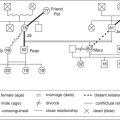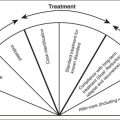Chapter 28 MANAGEMENT OF BEHAVIOUR IN DEMENTIA
INTRODUCTION
The dementia syndrome affects approximately 6.5% of older Australians and is characterised by cognitive impairment and a variety of non-cognitive clinical features, including psychological symptoms and challenging behaviours. The expression ‘behavioural and psychological symptoms of dementia’ (BPSD) was coined to provide an omnibus or umbrella term to describe these non-cognitive symptoms of dementia. These symptoms are also sometimes referred to as neuropsychiatric symptoms. BPSD include both psychological symptoms that are described by the older person and behaviours that are observed by others. This chapter provides an overview of BPSD and an approach to their assessment and management.
PREVALENCE
Most, if not all, people with dementia will develop BPSD at some point in their illness. In about 50% of cases, these symptoms will be clinically significant and either cause significant distress to the person with dementia or cause significant burden to carers, or both. In other cases, BPSD will be evident, but will not be a major focus of clinical attention or treatment. BPSD include psychological symptoms such as anxiety, depression, delusions and hallucinations, and challenging behaviours such as apathy, agitation, aggression and motor overactivity. The Cache County Study from the US state of Utah found that 97% of people with dementia had one or more BPSD at some point over a 5-year period. The 5-year prevalence of depression was 77%, of apathy was 71% and of anxiety was 62% (Steinberg et al 2008).
The persistence of BPSD has been investigated in the Maasbed Study from the Netherlands (Aalten et al 2005). In this study, 80.9% of people with dementia had one or more BPSD at baseline. The baseline prevalence of selected BPSD was as follows: apathy 40%; depression 35%; anxiety 21%; delusions 22%; hallucinations 10%; and agitation 19%. However, the prevalence of symptoms that persisted at each of four 6-monthly observation points over 2 years was much lower: apathy 12%; depression 2%; anxiety 1%; delusions 4%; hallucinations 2%; and agitation 0%. Thus, it is clear from this research that BPSD come and go. This has implications for uncontrolled research studies, as there is a significant risk in such studies that clinical improvement might be attributed to an intervention when it actually only reflects the natural fluctuations in BPSD prevalence over time. Thus, to be meaningful, BPSD intervention studies must have a valid control condition.
BPSD also occur in people with mild cognitive impairment (MCI) (Apostolova & Cummings 2008, Muangpaisan et al 2008) and in some people with subjective memory complaints (SMC) (Sohrabi et al 2009). In the large Cognitive Function and Ageing Study (CFAS) funded by the UK Medical Research Council (MRC) (Savva et al 2009), BPSD were found to be much more prevalent in older people with dementia than in older people without dementia, but mood symptoms, apathy, irritability and feelings of persecution were found in a significant proportion of people without dementia. Thus, the term BPSD actually refers to non-cognitive symptoms that are seen across the whole range of cognitive function in older people (not just those with dementia).
SIGNIFICANCE
BPSD are one of the risk factors for residential aged care facility (RACF) placement. In a US study, Yaffe et al (2002) found that BPSD were the fourth most important risk factor for RACF placement after living alone, having a Mini-Mental State Examination (MMSE) score of 20 or less, and having one or more activities of daily living (ADLs) dependencies. Older people with BPSD were 30% more likely than those without BPSD to be admitted to an RACF. The same study found that a Zarit Burden Interview (see Ch 35) score of 20 or greater was the most important caregiver risk factor for RACF placement. People with dementia whose caregiver reported a Zarit burden score of 20 or greater were 73% more likely to be admitted to an RACF.
There is a strong association between BPSD and carer burden, distress and depression (Black & Almeida 2004). Although there are undoubtedly emotional benefits that accrue to many carers of people with dementia as a result of their valued caregiving role, most carers report at least some sense of burden. However, burden needs to be distinguished from distress and depression, although the three phenomena are not mutually exclusive.
SYMPTOM CLUSTERS
Clinicians have long observed that certain BPSD tend to cluster together and these observations have been confirmed by research techniques, including factor analysis. In a factor analytic study conducted by the European Alzheimer’s Disease Consortium (Petrovic et al 2007), four factors were identified using the Neuropsychiatric Inventory (NPI): a psychosis factor (irritability, agitation, hallucinations and anxiety); a psychomotor factor (aberrant motor behaviour and delusions); a mood lability factor (disinhibition, elation and depression); and an instinctual factor (appetite disturbance, sleep disturbance and apathy). The investigators pointed out that the association between elation, depression and disinhibition might have implications for treatment.
DIFFERENTIAL DIAGNOSIS
Challenging behaviours in people with dementia can occur for a variety of reasons, including delirium, preexisting mental health problem (including psychosis, depression and anxiety), behavioural toxicity of prescribed medication, substance abuse or dependence, and intercurrent general medical problems (e.g. chest infection or acute coronary syndrome). Sometimes, challenging behaviours simply reflect longstanding patterns of antisocial behaviour.
AETIOLOGY
By definition, the principal aetiological factor in BPSD is thought to be the underlying dementia syndrome. However, there are substantial individual differences in the pattern and severity of BPSD that are likely to relate to other aetiological factors. Some BPSD occur more commonly in people with particular types of dementia. For example, delusions are more prevalent in dementia due to Alzheimer’s disease, whereas depression is more common in dementia due to cerebrovascular disease (Lyketsos et al 2000). Behavioural disturbance occurs early in the course of the behavioural variant of frontotemporal dementia, often before cognitive impairment is obvious.
The premorbid personality of the person with dementia is likely to influence their current behaviour. In particular, there is evidence that high levels of neuroticism are a risk factor for anxiety in people with dementia, and that high levels of agreeableness protect against agitation and irritability (Archer et al 2007).
Depression may be associated with behavioural change in someone who is unable to effectively express their distress any other way. For example, there is evidence that people with dementia and disruptive vocalisation (i.e. screaming and repetitive calling out) are more likely to be depressed than people with dementia without disruptive vocalisation (Dwyer & Byrne 2000). Pain is another powerful precipitant of challenging behaviour in people with dementia, who are often unable to articulate the source of their distress. Thus, for example, pain from arthritis or from headache might lead to psychological distress that manifests as one or more BPSD.
Sometimes, the person with dementia responds with challenging behaviour because they have been abused or neglected by others. In institutional settings, rigid care schedules may evoke behavioural resistance to care. Poor hearing or eyesight can contribute to sensory deprivation, and in the context of cognitive impairment may lead to BPSD. BPSD can be manifestations of intercurrent general medical problems, including delirium (see Ch 19).
Genetic polymorphisms may also influence BPSD. These genetic variants are known to affect the activity of neurotransmitter transporter systems in the brain and are likely to play a part in why some people with dementia get severe BPSD and others get mild BPSD (Pritchard et al 2007, 2008).
SCALES TO MEASURE BPSD
Many scales have been developed to measure BPSD. Some of these are scales that measure single constructs, such as depression (e.g. the Cornell Scale for Depression in Dementia (CSDD)) (Alexopoulos et al 1988), whereas others are omnibus scales that measure a range of phenomena. Popular omnibus scales include the Neuropsychiatric Inventory (NPI) (Cummings et al 1994, Cummings 1997) and the Cohen-Mansfield Agitation Inventory (CMAI) (Cohen-Mansfield 1986).
The CSDD is a 19-item clinician-rated instrument that rates five classes of depressive symptoms on a 3-point response scale. The NPI is a set of 12 scales (see box below), covering 10 neuropsychiatric symptoms and two vegetative symptoms (appetite and sleep) rated by a clinician following an interview with a caregiver. The CMAI includes 29 challenging behaviours, which are usually rated by nursing personnel. The NPI employs response scales that rate the frequency and severity of each item, as well as the degree of caregiver distress caused by the symptom. The CMAI employs response scales that rate the frequency and disruptiveness of each symptom. The CSDD is commonly used in both clinical and research settings and is part of the routine data set collected in Australian RACFs. The NPI is commonly used in both clinical and research settings involving people with mild to moderate dementia, whereas the CMAI is commonly used in clinical and research settings involving people in RACF settings. See also Chapter 35.
INITIAL ASSESSMENT OF BPSD
For the initial BPSD assessment:
Stay updated, free articles. Join our Telegram channel

Full access? Get Clinical Tree





